Physiological Principles for Health and Social Care: A Detailed Report
VerifiedAdded on 2024/06/07
|23
|7086
|131
Report
AI Summary
This report delves into the physiological principles governing the human body, covering anatomical features, interactions between body systems, and normal body responses to everyday activities. It explains how cellular and tissue structure relates to physiological functions and how the body coordinates its internal activities. The report also assesses the use of routine measures in health and social care, examining how these measures provide information about body functioning and inform care planning for individuals. Furthermore, it addresses the effects of age and common disorders on body structure and function, relating these effects to the routine care given to affected individuals. This document is a comprehensive overview of human physiology and its practical applications in health and social care.
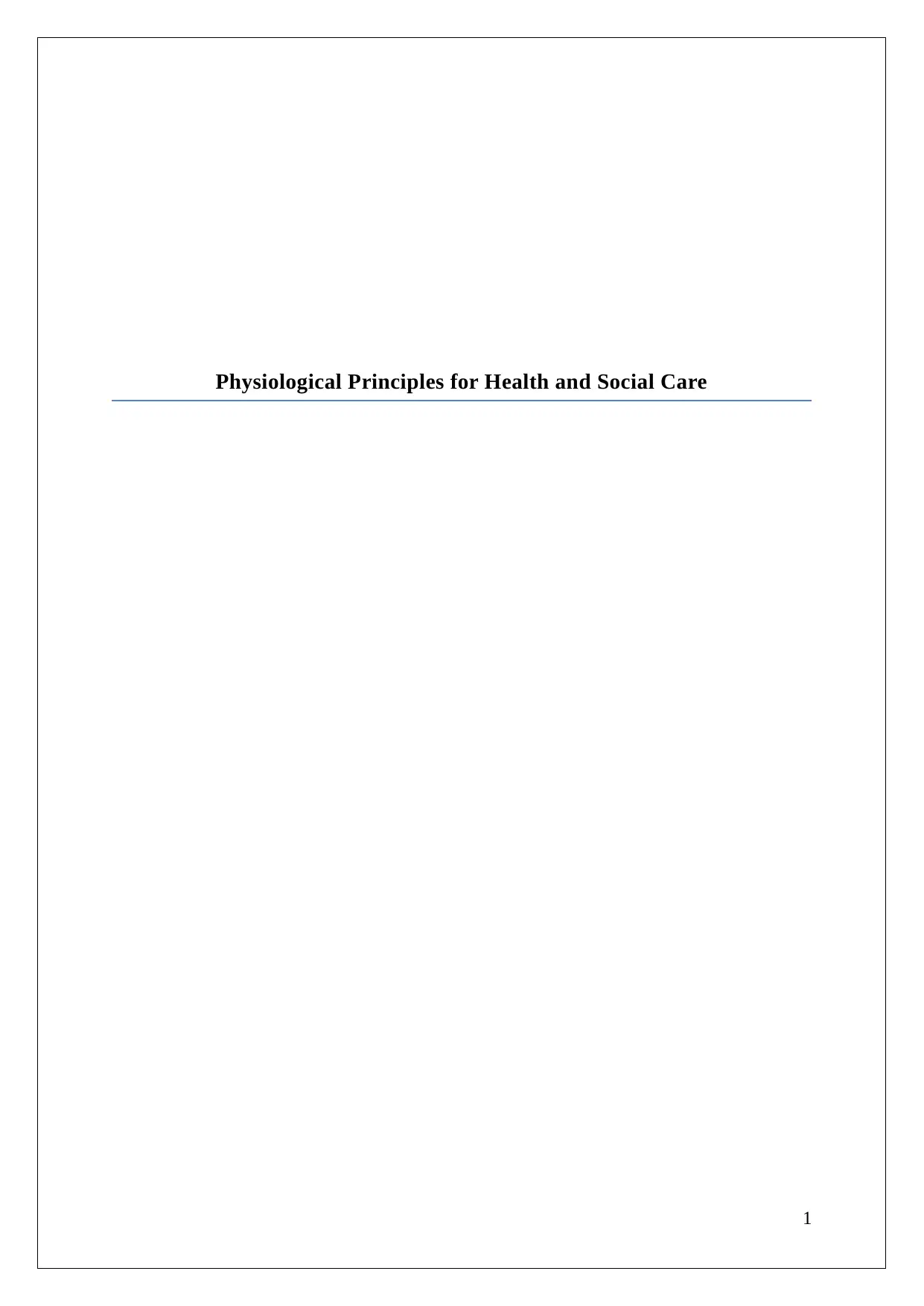
Physiological Principles for Health and Social Care
1
1
Paraphrase This Document
Need a fresh take? Get an instant paraphrase of this document with our AI Paraphraser

Table of Contents
Introduction................................................................................................................................3
Task 1.........................................................................................................................................4
1.1 Outline the main anatomical features of the human body....................................................4
1.2 Discuss how body systems interact to ensure the body functions and grows......................5
Task 2.........................................................................................................................................7
2.1 Explain normal body responses to everyday activities........................................................7
2.2 Discuss the body responses are explained by cellular and tissue structure and physiology 8
2.3 Explain how the body coordinates its internal activities......................................................9
Task 3.......................................................................................................................................11
3.1 Explain the recording and use of routine measures in health and social care....................11
3.2 Assess how routine measures provide information about body functioning.....................12
3.3 Examine how information about body functioning may inform care planning for
individuals................................................................................................................................12
Task 4.......................................................................................................................................14
4.1 Explain how age may affect body structure and functioning.............................................14
4.2 Assess the impact of common disorders on body structure and functioning.....................15
4.3 Relate the effects of common disorders and infection to the care routinely given to
individuals affected by them....................................................................................................16
Conclusion................................................................................................................................19
References................................................................................................................................20
2
Introduction................................................................................................................................3
Task 1.........................................................................................................................................4
1.1 Outline the main anatomical features of the human body....................................................4
1.2 Discuss how body systems interact to ensure the body functions and grows......................5
Task 2.........................................................................................................................................7
2.1 Explain normal body responses to everyday activities........................................................7
2.2 Discuss the body responses are explained by cellular and tissue structure and physiology 8
2.3 Explain how the body coordinates its internal activities......................................................9
Task 3.......................................................................................................................................11
3.1 Explain the recording and use of routine measures in health and social care....................11
3.2 Assess how routine measures provide information about body functioning.....................12
3.3 Examine how information about body functioning may inform care planning for
individuals................................................................................................................................12
Task 4.......................................................................................................................................14
4.1 Explain how age may affect body structure and functioning.............................................14
4.2 Assess the impact of common disorders on body structure and functioning.....................15
4.3 Relate the effects of common disorders and infection to the care routinely given to
individuals affected by them....................................................................................................16
Conclusion................................................................................................................................19
References................................................................................................................................20
2
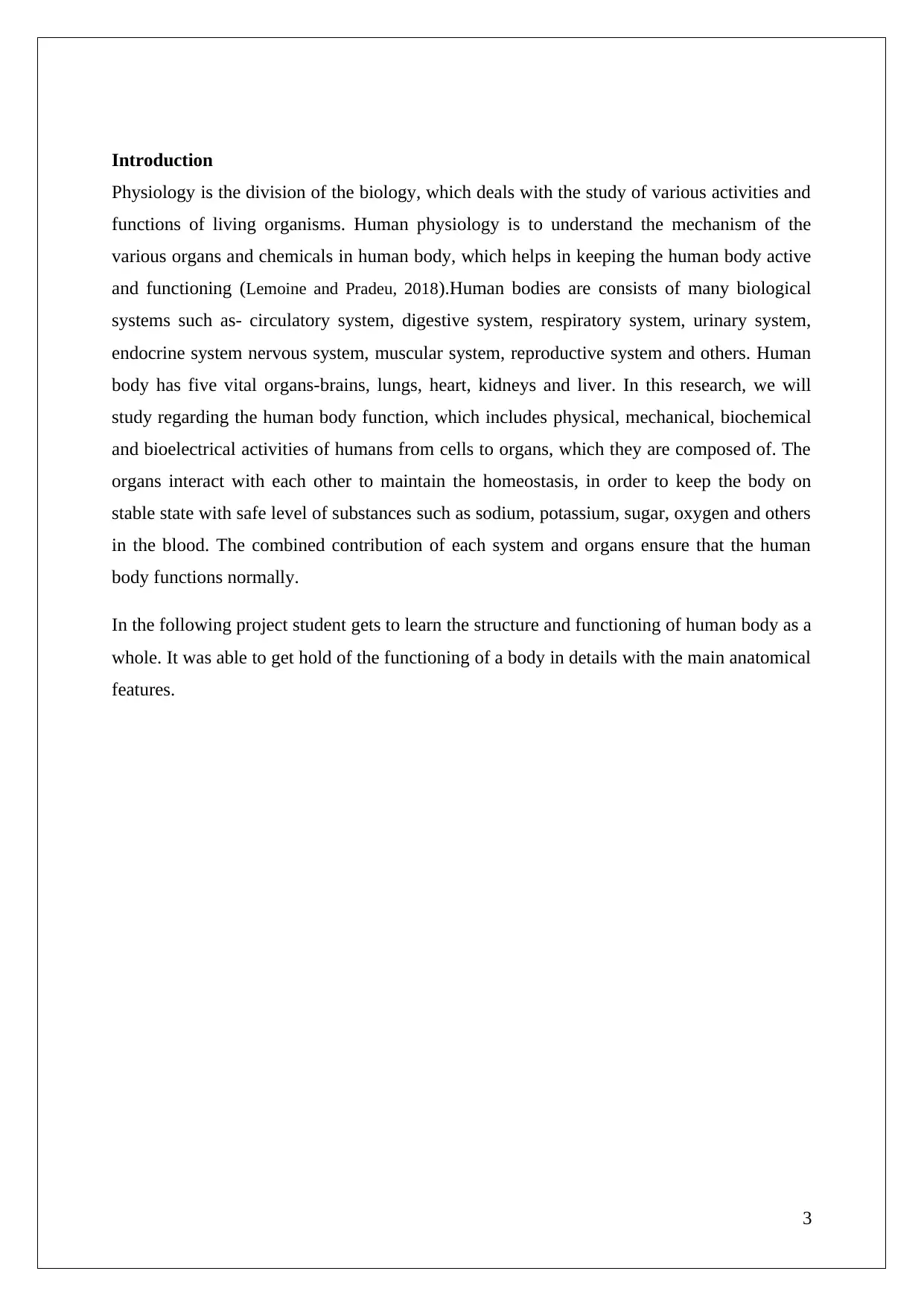
Introduction
Physiology is the division of the biology, which deals with the study of various activities and
functions of living organisms. Human physiology is to understand the mechanism of the
various organs and chemicals in human body, which helps in keeping the human body active
and functioning (Lemoine and Pradeu, 2018).Human bodies are consists of many biological
systems such as- circulatory system, digestive system, respiratory system, urinary system,
endocrine system nervous system, muscular system, reproductive system and others. Human
body has five vital organs-brains, lungs, heart, kidneys and liver. In this research, we will
study regarding the human body function, which includes physical, mechanical, biochemical
and bioelectrical activities of humans from cells to organs, which they are composed of. The
organs interact with each other to maintain the homeostasis, in order to keep the body on
stable state with safe level of substances such as sodium, potassium, sugar, oxygen and others
in the blood. The combined contribution of each system and organs ensure that the human
body functions normally.
In the following project student gets to learn the structure and functioning of human body as a
whole. It was able to get hold of the functioning of a body in details with the main anatomical
features.
3
Physiology is the division of the biology, which deals with the study of various activities and
functions of living organisms. Human physiology is to understand the mechanism of the
various organs and chemicals in human body, which helps in keeping the human body active
and functioning (Lemoine and Pradeu, 2018).Human bodies are consists of many biological
systems such as- circulatory system, digestive system, respiratory system, urinary system,
endocrine system nervous system, muscular system, reproductive system and others. Human
body has five vital organs-brains, lungs, heart, kidneys and liver. In this research, we will
study regarding the human body function, which includes physical, mechanical, biochemical
and bioelectrical activities of humans from cells to organs, which they are composed of. The
organs interact with each other to maintain the homeostasis, in order to keep the body on
stable state with safe level of substances such as sodium, potassium, sugar, oxygen and others
in the blood. The combined contribution of each system and organs ensure that the human
body functions normally.
In the following project student gets to learn the structure and functioning of human body as a
whole. It was able to get hold of the functioning of a body in details with the main anatomical
features.
3
⊘ This is a preview!⊘
Do you want full access?
Subscribe today to unlock all pages.

Trusted by 1+ million students worldwide

Task 1
1.1 Outline the main anatomical features of the human body
A human body is the structure that makes a human being. It is made up of a variety of cells
and tissues needed to make a body function (Standring, 2015). It comprises of the essentials
such as neck, legs, hands and head. A human body has to perform various functions in order
to live. The main anatomical features are as follows:
Gross Features:
Head- The head consists of the facial and cranial parts of a human body. The facial part
components are forehead, eyes, ears, nose, mouth and cheeks. The eye consists of eyelids and
eyelashes. They are the organs, which help a human to have sight. Nose has the function to
breathe. The ears function is to hear and respond to things.
Trunk- The head is attached to the truck by neck. The trunk of a human body consists of
chest, shoulders and abdomens. It has the main functions to perform as it includes the internal
organs, which cannot be seen, i.e. heart, liver, stomach, pancreas, spleen, kidneys, small and
large intestines.
Limbs- The components of limbs are arms and legs. The arm consists of upper arm, wrist,
hand, forearm and fingers. The hands inner side is known a palm. There are even nails and
tips of the finger (Mogali et al., 2018). The composition of legs is thighs, ankle, foot, knee
and calf. The foot has the heel and sole and it even has the five toes
Abdomen- It is commonly known as belly. It contains the digestive organs such as stomach,
small and large intestines. There are many important vessels, which are connected and go
through the abdomen. It even consists of the kidney and spleen. A tissue named as fascia
protects the front of the abdomen. To protect the fascia, it has the skin and abdominal
muscles. At the back of abdomen is the spine and back muscle.
Pelvis- It the area between trunk and the lower limbs. The females and males have different
structure. However, the differences only become noticeable after puberty. The pelvic bones
are of a broader width and are larger than the male counterparts as it has to have more space
at the time of childbirth (Gruss and Schmitt, 2015).
4
1.1 Outline the main anatomical features of the human body
A human body is the structure that makes a human being. It is made up of a variety of cells
and tissues needed to make a body function (Standring, 2015). It comprises of the essentials
such as neck, legs, hands and head. A human body has to perform various functions in order
to live. The main anatomical features are as follows:
Gross Features:
Head- The head consists of the facial and cranial parts of a human body. The facial part
components are forehead, eyes, ears, nose, mouth and cheeks. The eye consists of eyelids and
eyelashes. They are the organs, which help a human to have sight. Nose has the function to
breathe. The ears function is to hear and respond to things.
Trunk- The head is attached to the truck by neck. The trunk of a human body consists of
chest, shoulders and abdomens. It has the main functions to perform as it includes the internal
organs, which cannot be seen, i.e. heart, liver, stomach, pancreas, spleen, kidneys, small and
large intestines.
Limbs- The components of limbs are arms and legs. The arm consists of upper arm, wrist,
hand, forearm and fingers. The hands inner side is known a palm. There are even nails and
tips of the finger (Mogali et al., 2018). The composition of legs is thighs, ankle, foot, knee
and calf. The foot has the heel and sole and it even has the five toes
Abdomen- It is commonly known as belly. It contains the digestive organs such as stomach,
small and large intestines. There are many important vessels, which are connected and go
through the abdomen. It even consists of the kidney and spleen. A tissue named as fascia
protects the front of the abdomen. To protect the fascia, it has the skin and abdominal
muscles. At the back of abdomen is the spine and back muscle.
Pelvis- It the area between trunk and the lower limbs. The females and males have different
structure. However, the differences only become noticeable after puberty. The pelvic bones
are of a broader width and are larger than the male counterparts as it has to have more space
at the time of childbirth (Gruss and Schmitt, 2015).
4
Paraphrase This Document
Need a fresh take? Get an instant paraphrase of this document with our AI Paraphraser
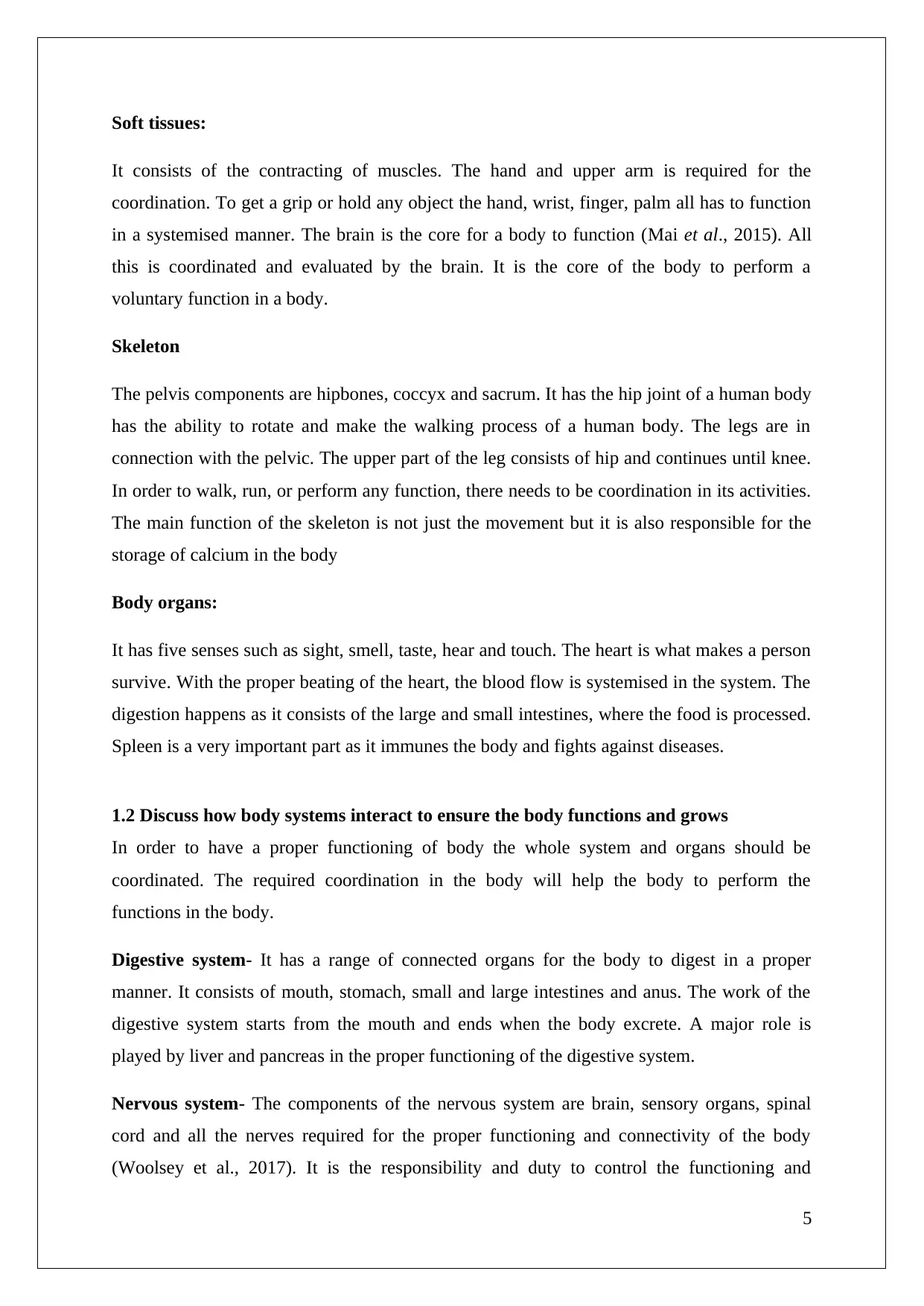
Soft tissues:
It consists of the contracting of muscles. The hand and upper arm is required for the
coordination. To get a grip or hold any object the hand, wrist, finger, palm all has to function
in a systemised manner. The brain is the core for a body to function (Mai et al., 2015). All
this is coordinated and evaluated by the brain. It is the core of the body to perform a
voluntary function in a body.
Skeleton
The pelvis components are hipbones, coccyx and sacrum. It has the hip joint of a human body
has the ability to rotate and make the walking process of a human body. The legs are in
connection with the pelvic. The upper part of the leg consists of hip and continues until knee.
In order to walk, run, or perform any function, there needs to be coordination in its activities.
The main function of the skeleton is not just the movement but it is also responsible for the
storage of calcium in the body
Body organs:
It has five senses such as sight, smell, taste, hear and touch. The heart is what makes a person
survive. With the proper beating of the heart, the blood flow is systemised in the system. The
digestion happens as it consists of the large and small intestines, where the food is processed.
Spleen is a very important part as it immunes the body and fights against diseases.
1.2 Discuss how body systems interact to ensure the body functions and grows
In order to have a proper functioning of body the whole system and organs should be
coordinated. The required coordination in the body will help the body to perform the
functions in the body.
Digestive system- It has a range of connected organs for the body to digest in a proper
manner. It consists of mouth, stomach, small and large intestines and anus. The work of the
digestive system starts from the mouth and ends when the body excrete. A major role is
played by liver and pancreas in the proper functioning of the digestive system.
Nervous system- The components of the nervous system are brain, sensory organs, spinal
cord and all the nerves required for the proper functioning and connectivity of the body
(Woolsey et al., 2017). It is the responsibility and duty to control the functioning and
5
It consists of the contracting of muscles. The hand and upper arm is required for the
coordination. To get a grip or hold any object the hand, wrist, finger, palm all has to function
in a systemised manner. The brain is the core for a body to function (Mai et al., 2015). All
this is coordinated and evaluated by the brain. It is the core of the body to perform a
voluntary function in a body.
Skeleton
The pelvis components are hipbones, coccyx and sacrum. It has the hip joint of a human body
has the ability to rotate and make the walking process of a human body. The legs are in
connection with the pelvic. The upper part of the leg consists of hip and continues until knee.
In order to walk, run, or perform any function, there needs to be coordination in its activities.
The main function of the skeleton is not just the movement but it is also responsible for the
storage of calcium in the body
Body organs:
It has five senses such as sight, smell, taste, hear and touch. The heart is what makes a person
survive. With the proper beating of the heart, the blood flow is systemised in the system. The
digestion happens as it consists of the large and small intestines, where the food is processed.
Spleen is a very important part as it immunes the body and fights against diseases.
1.2 Discuss how body systems interact to ensure the body functions and grows
In order to have a proper functioning of body the whole system and organs should be
coordinated. The required coordination in the body will help the body to perform the
functions in the body.
Digestive system- It has a range of connected organs for the body to digest in a proper
manner. It consists of mouth, stomach, small and large intestines and anus. The work of the
digestive system starts from the mouth and ends when the body excrete. A major role is
played by liver and pancreas in the proper functioning of the digestive system.
Nervous system- The components of the nervous system are brain, sensory organs, spinal
cord and all the nerves required for the proper functioning and connectivity of the body
(Woolsey et al., 2017). It is the responsibility and duty to control the functioning and
5
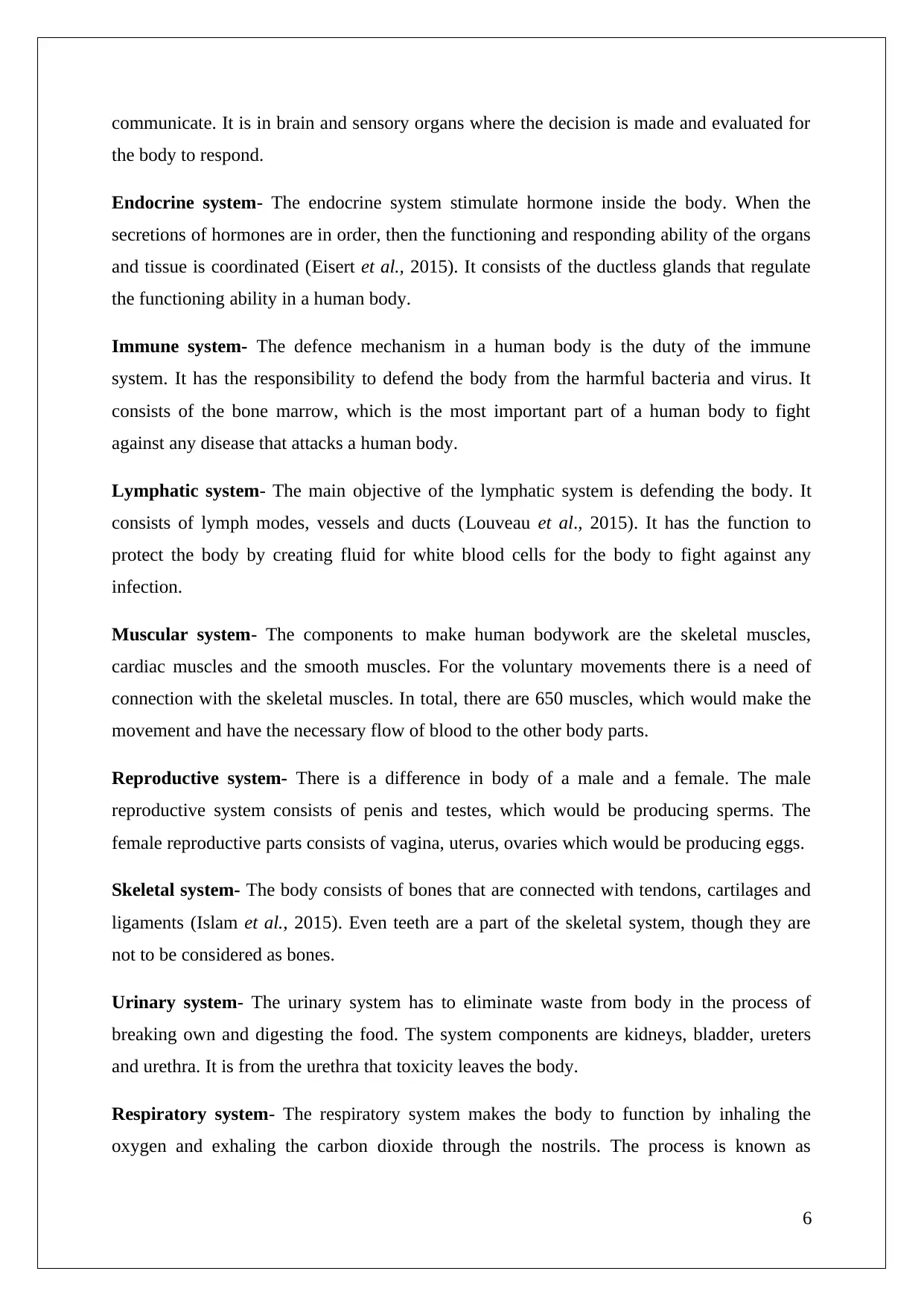
communicate. It is in brain and sensory organs where the decision is made and evaluated for
the body to respond.
Endocrine system- The endocrine system stimulate hormone inside the body. When the
secretions of hormones are in order, then the functioning and responding ability of the organs
and tissue is coordinated (Eisert et al., 2015). It consists of the ductless glands that regulate
the functioning ability in a human body.
Immune system- The defence mechanism in a human body is the duty of the immune
system. It has the responsibility to defend the body from the harmful bacteria and virus. It
consists of the bone marrow, which is the most important part of a human body to fight
against any disease that attacks a human body.
Lymphatic system- The main objective of the lymphatic system is defending the body. It
consists of lymph modes, vessels and ducts (Louveau et al., 2015). It has the function to
protect the body by creating fluid for white blood cells for the body to fight against any
infection.
Muscular system- The components to make human bodywork are the skeletal muscles,
cardiac muscles and the smooth muscles. For the voluntary movements there is a need of
connection with the skeletal muscles. In total, there are 650 muscles, which would make the
movement and have the necessary flow of blood to the other body parts.
Reproductive system- There is a difference in body of a male and a female. The male
reproductive system consists of penis and testes, which would be producing sperms. The
female reproductive parts consists of vagina, uterus, ovaries which would be producing eggs.
Skeletal system- The body consists of bones that are connected with tendons, cartilages and
ligaments (Islam et al., 2015). Even teeth are a part of the skeletal system, though they are
not to be considered as bones.
Urinary system- The urinary system has to eliminate waste from body in the process of
breaking own and digesting the food. The system components are kidneys, bladder, ureters
and urethra. It is from the urethra that toxicity leaves the body.
Respiratory system- The respiratory system makes the body to function by inhaling the
oxygen and exhaling the carbon dioxide through the nostrils. The process is known as
6
the body to respond.
Endocrine system- The endocrine system stimulate hormone inside the body. When the
secretions of hormones are in order, then the functioning and responding ability of the organs
and tissue is coordinated (Eisert et al., 2015). It consists of the ductless glands that regulate
the functioning ability in a human body.
Immune system- The defence mechanism in a human body is the duty of the immune
system. It has the responsibility to defend the body from the harmful bacteria and virus. It
consists of the bone marrow, which is the most important part of a human body to fight
against any disease that attacks a human body.
Lymphatic system- The main objective of the lymphatic system is defending the body. It
consists of lymph modes, vessels and ducts (Louveau et al., 2015). It has the function to
protect the body by creating fluid for white blood cells for the body to fight against any
infection.
Muscular system- The components to make human bodywork are the skeletal muscles,
cardiac muscles and the smooth muscles. For the voluntary movements there is a need of
connection with the skeletal muscles. In total, there are 650 muscles, which would make the
movement and have the necessary flow of blood to the other body parts.
Reproductive system- There is a difference in body of a male and a female. The male
reproductive system consists of penis and testes, which would be producing sperms. The
female reproductive parts consists of vagina, uterus, ovaries which would be producing eggs.
Skeletal system- The body consists of bones that are connected with tendons, cartilages and
ligaments (Islam et al., 2015). Even teeth are a part of the skeletal system, though they are
not to be considered as bones.
Urinary system- The urinary system has to eliminate waste from body in the process of
breaking own and digesting the food. The system components are kidneys, bladder, ureters
and urethra. It is from the urethra that toxicity leaves the body.
Respiratory system- The respiratory system makes the body to function by inhaling the
oxygen and exhaling the carbon dioxide through the nostrils. The process is known as
6
⊘ This is a preview!⊘
Do you want full access?
Subscribe today to unlock all pages.

Trusted by 1+ million students worldwide
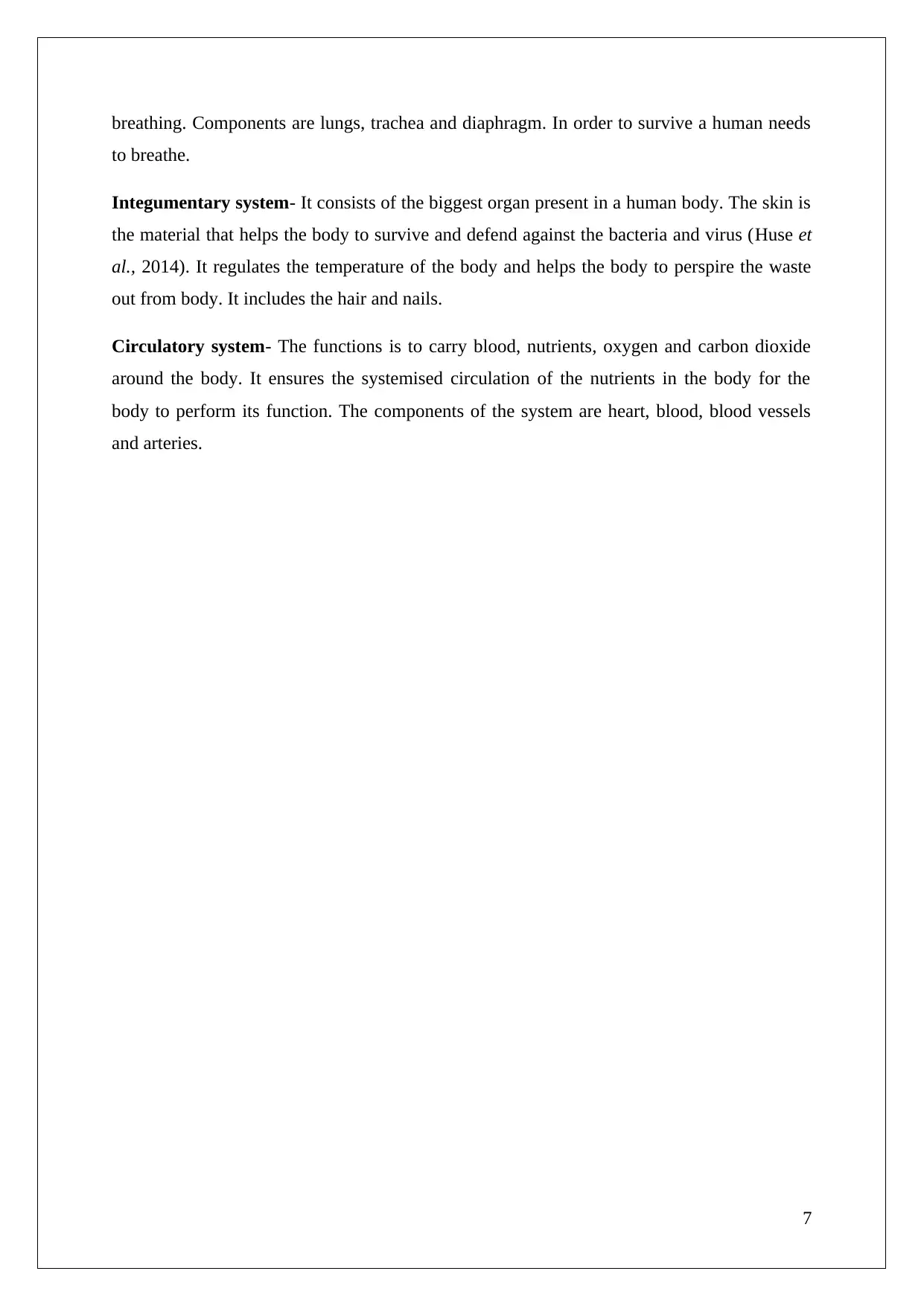
breathing. Components are lungs, trachea and diaphragm. In order to survive a human needs
to breathe.
Integumentary system- It consists of the biggest organ present in a human body. The skin is
the material that helps the body to survive and defend against the bacteria and virus (Huse et
al., 2014). It regulates the temperature of the body and helps the body to perspire the waste
out from body. It includes the hair and nails.
Circulatory system- The functions is to carry blood, nutrients, oxygen and carbon dioxide
around the body. It ensures the systemised circulation of the nutrients in the body for the
body to perform its function. The components of the system are heart, blood, blood vessels
and arteries.
7
to breathe.
Integumentary system- It consists of the biggest organ present in a human body. The skin is
the material that helps the body to survive and defend against the bacteria and virus (Huse et
al., 2014). It regulates the temperature of the body and helps the body to perspire the waste
out from body. It includes the hair and nails.
Circulatory system- The functions is to carry blood, nutrients, oxygen and carbon dioxide
around the body. It ensures the systemised circulation of the nutrients in the body for the
body to perform its function. The components of the system are heart, blood, blood vessels
and arteries.
7
Paraphrase This Document
Need a fresh take? Get an instant paraphrase of this document with our AI Paraphraser
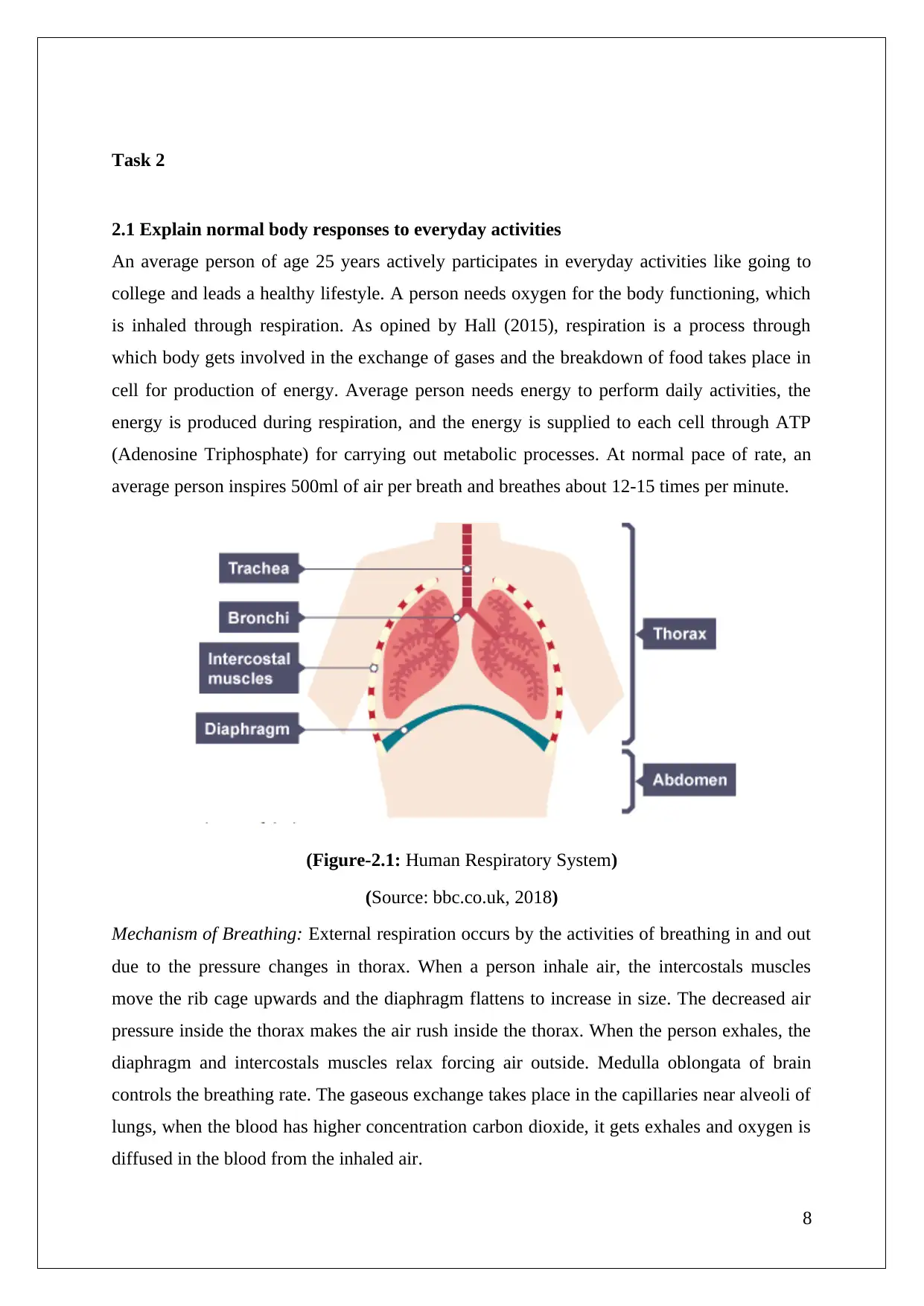
Task 2
2.1 Explain normal body responses to everyday activities
An average person of age 25 years actively participates in everyday activities like going to
college and leads a healthy lifestyle. A person needs oxygen for the body functioning, which
is inhaled through respiration. As opined by Hall (2015), respiration is a process through
which body gets involved in the exchange of gases and the breakdown of food takes place in
cell for production of energy. Average person needs energy to perform daily activities, the
energy is produced during respiration, and the energy is supplied to each cell through ATP
(Adenosine Triphosphate) for carrying out metabolic processes. At normal pace of rate, an
average person inspires 500ml of air per breath and breathes about 12-15 times per minute.
(Figure-2.1: Human Respiratory System)
(Source: bbc.co.uk, 2018)
Mechanism of Breathing: External respiration occurs by the activities of breathing in and out
due to the pressure changes in thorax. When a person inhale air, the intercostals muscles
move the rib cage upwards and the diaphragm flattens to increase in size. The decreased air
pressure inside the thorax makes the air rush inside the thorax. When the person exhales, the
diaphragm and intercostals muscles relax forcing air outside. Medulla oblongata of brain
controls the breathing rate. The gaseous exchange takes place in the capillaries near alveoli of
lungs, when the blood has higher concentration carbon dioxide, it gets exhales and oxygen is
diffused in the blood from the inhaled air.
8
2.1 Explain normal body responses to everyday activities
An average person of age 25 years actively participates in everyday activities like going to
college and leads a healthy lifestyle. A person needs oxygen for the body functioning, which
is inhaled through respiration. As opined by Hall (2015), respiration is a process through
which body gets involved in the exchange of gases and the breakdown of food takes place in
cell for production of energy. Average person needs energy to perform daily activities, the
energy is produced during respiration, and the energy is supplied to each cell through ATP
(Adenosine Triphosphate) for carrying out metabolic processes. At normal pace of rate, an
average person inspires 500ml of air per breath and breathes about 12-15 times per minute.
(Figure-2.1: Human Respiratory System)
(Source: bbc.co.uk, 2018)
Mechanism of Breathing: External respiration occurs by the activities of breathing in and out
due to the pressure changes in thorax. When a person inhale air, the intercostals muscles
move the rib cage upwards and the diaphragm flattens to increase in size. The decreased air
pressure inside the thorax makes the air rush inside the thorax. When the person exhales, the
diaphragm and intercostals muscles relax forcing air outside. Medulla oblongata of brain
controls the breathing rate. The gaseous exchange takes place in the capillaries near alveoli of
lungs, when the blood has higher concentration carbon dioxide, it gets exhales and oxygen is
diffused in the blood from the inhaled air.
8
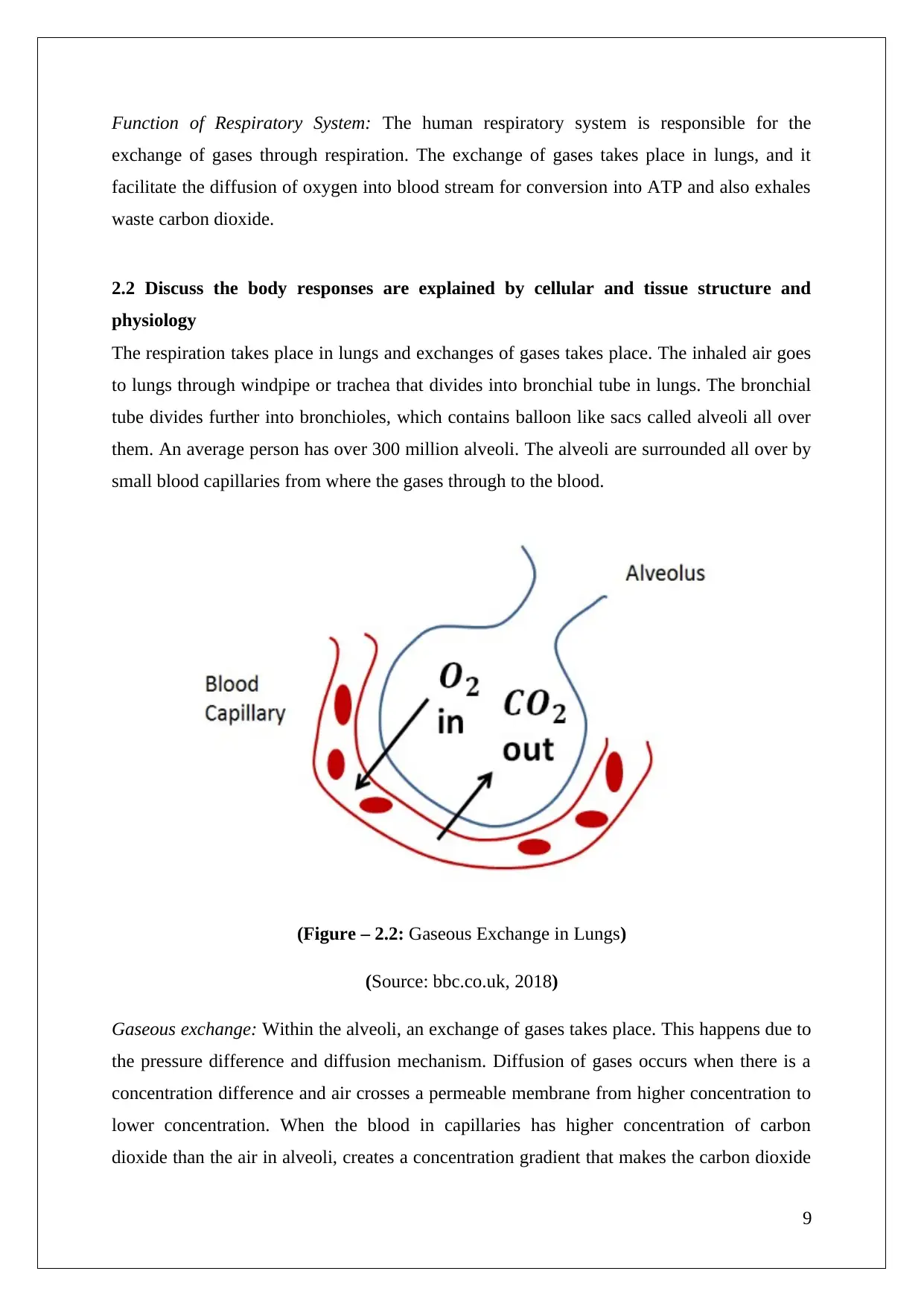
Function of Respiratory System: The human respiratory system is responsible for the
exchange of gases through respiration. The exchange of gases takes place in lungs, and it
facilitate the diffusion of oxygen into blood stream for conversion into ATP and also exhales
waste carbon dioxide.
2.2 Discuss the body responses are explained by cellular and tissue structure and
physiology
The respiration takes place in lungs and exchanges of gases takes place. The inhaled air goes
to lungs through windpipe or trachea that divides into bronchial tube in lungs. The bronchial
tube divides further into bronchioles, which contains balloon like sacs called alveoli all over
them. An average person has over 300 million alveoli. The alveoli are surrounded all over by
small blood capillaries from where the gases through to the blood.
(Figure – 2.2: Gaseous Exchange in Lungs)
(Source: bbc.co.uk, 2018)
Gaseous exchange: Within the alveoli, an exchange of gases takes place. This happens due to
the pressure difference and diffusion mechanism. Diffusion of gases occurs when there is a
concentration difference and air crosses a permeable membrane from higher concentration to
lower concentration. When the blood in capillaries has higher concentration of carbon
dioxide than the air in alveoli, creates a concentration gradient that makes the carbon dioxide
9
exchange of gases through respiration. The exchange of gases takes place in lungs, and it
facilitate the diffusion of oxygen into blood stream for conversion into ATP and also exhales
waste carbon dioxide.
2.2 Discuss the body responses are explained by cellular and tissue structure and
physiology
The respiration takes place in lungs and exchanges of gases takes place. The inhaled air goes
to lungs through windpipe or trachea that divides into bronchial tube in lungs. The bronchial
tube divides further into bronchioles, which contains balloon like sacs called alveoli all over
them. An average person has over 300 million alveoli. The alveoli are surrounded all over by
small blood capillaries from where the gases through to the blood.
(Figure – 2.2: Gaseous Exchange in Lungs)
(Source: bbc.co.uk, 2018)
Gaseous exchange: Within the alveoli, an exchange of gases takes place. This happens due to
the pressure difference and diffusion mechanism. Diffusion of gases occurs when there is a
concentration difference and air crosses a permeable membrane from higher concentration to
lower concentration. When the blood in capillaries has higher concentration of carbon
dioxide than the air in alveoli, creates a concentration gradient that makes the carbon dioxide
9
⊘ This is a preview!⊘
Do you want full access?
Subscribe today to unlock all pages.

Trusted by 1+ million students worldwide
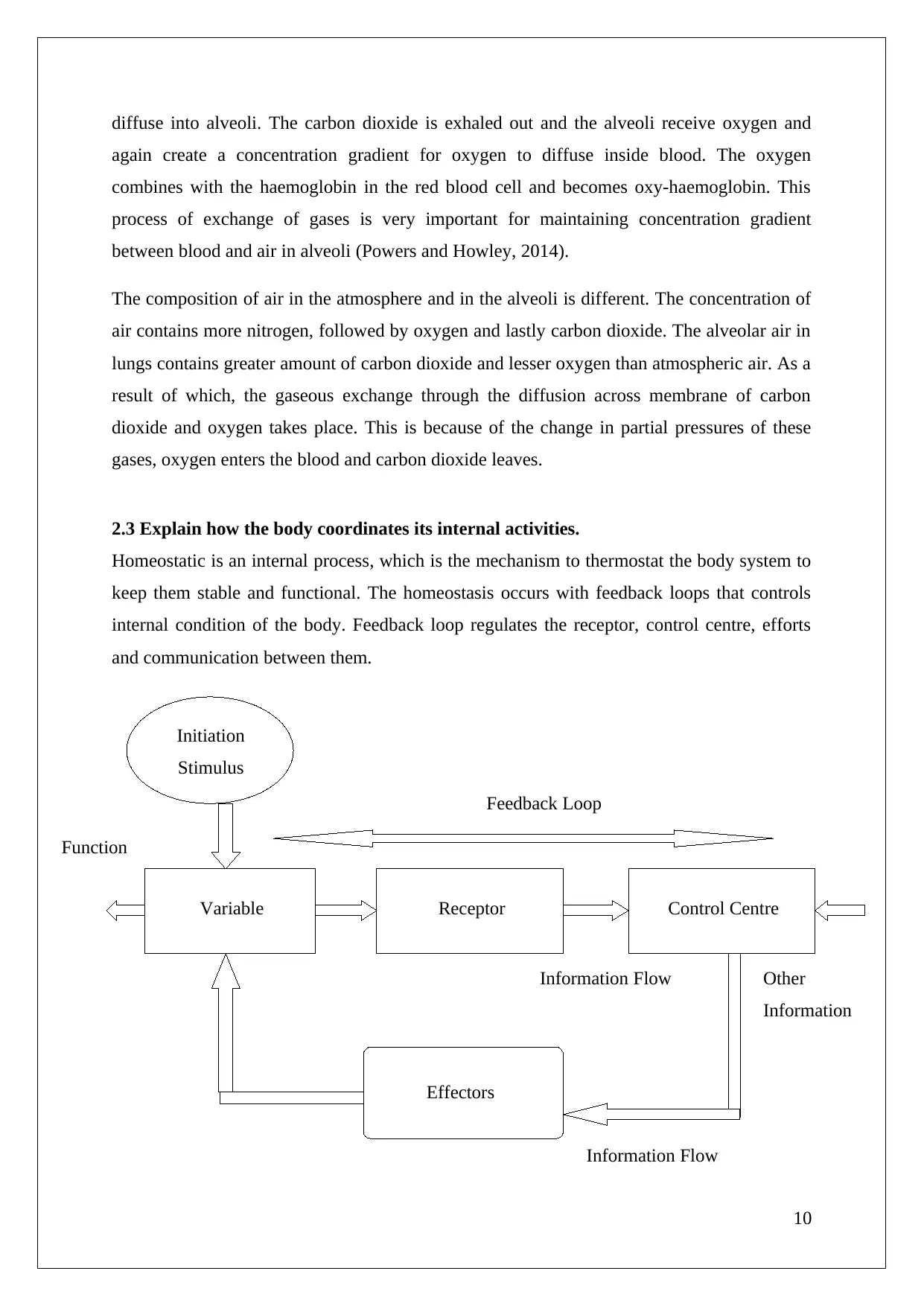
diffuse into alveoli. The carbon dioxide is exhaled out and the alveoli receive oxygen and
again create a concentration gradient for oxygen to diffuse inside blood. The oxygen
combines with the haemoglobin in the red blood cell and becomes oxy-haemoglobin. This
process of exchange of gases is very important for maintaining concentration gradient
between blood and air in alveoli (Powers and Howley, 2014).
The composition of air in the atmosphere and in the alveoli is different. The concentration of
air contains more nitrogen, followed by oxygen and lastly carbon dioxide. The alveolar air in
lungs contains greater amount of carbon dioxide and lesser oxygen than atmospheric air. As a
result of which, the gaseous exchange through the diffusion across membrane of carbon
dioxide and oxygen takes place. This is because of the change in partial pressures of these
gases, oxygen enters the blood and carbon dioxide leaves.
2.3 Explain how the body coordinates its internal activities.
Homeostatic is an internal process, which is the mechanism to thermostat the body system to
keep them stable and functional. The homeostasis occurs with feedback loops that controls
internal condition of the body. Feedback loop regulates the receptor, control centre, efforts
and communication between them.
10
Initiation
Stimulus
Variable Receptor Control Centre
Effectors
Function
Feedback Loop
Information Flow
Information Flow
Other
Information
again create a concentration gradient for oxygen to diffuse inside blood. The oxygen
combines with the haemoglobin in the red blood cell and becomes oxy-haemoglobin. This
process of exchange of gases is very important for maintaining concentration gradient
between blood and air in alveoli (Powers and Howley, 2014).
The composition of air in the atmosphere and in the alveoli is different. The concentration of
air contains more nitrogen, followed by oxygen and lastly carbon dioxide. The alveolar air in
lungs contains greater amount of carbon dioxide and lesser oxygen than atmospheric air. As a
result of which, the gaseous exchange through the diffusion across membrane of carbon
dioxide and oxygen takes place. This is because of the change in partial pressures of these
gases, oxygen enters the blood and carbon dioxide leaves.
2.3 Explain how the body coordinates its internal activities.
Homeostatic is an internal process, which is the mechanism to thermostat the body system to
keep them stable and functional. The homeostasis occurs with feedback loops that controls
internal condition of the body. Feedback loop regulates the receptor, control centre, efforts
and communication between them.
10
Initiation
Stimulus
Variable Receptor Control Centre
Effectors
Function
Feedback Loop
Information Flow
Information Flow
Other
Information
Paraphrase This Document
Need a fresh take? Get an instant paraphrase of this document with our AI Paraphraser
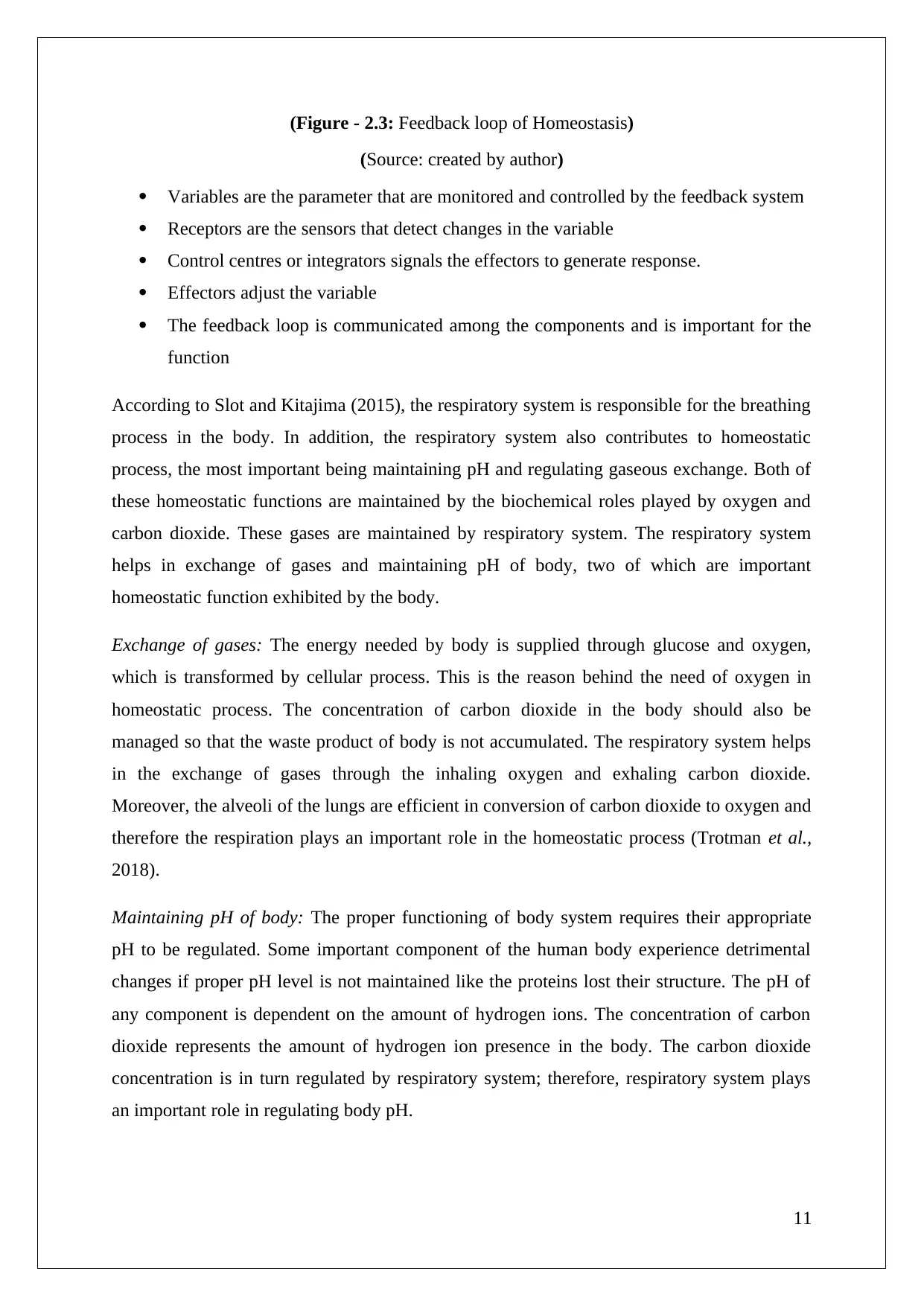
(Figure - 2.3: Feedback loop of Homeostasis)
(Source: created by author)
Variables are the parameter that are monitored and controlled by the feedback system
Receptors are the sensors that detect changes in the variable
Control centres or integrators signals the effectors to generate response.
Effectors adjust the variable
The feedback loop is communicated among the components and is important for the
function
According to Slot and Kitajima (2015), the respiratory system is responsible for the breathing
process in the body. In addition, the respiratory system also contributes to homeostatic
process, the most important being maintaining pH and regulating gaseous exchange. Both of
these homeostatic functions are maintained by the biochemical roles played by oxygen and
carbon dioxide. These gases are maintained by respiratory system. The respiratory system
helps in exchange of gases and maintaining pH of body, two of which are important
homeostatic function exhibited by the body.
Exchange of gases: The energy needed by body is supplied through glucose and oxygen,
which is transformed by cellular process. This is the reason behind the need of oxygen in
homeostatic process. The concentration of carbon dioxide in the body should also be
managed so that the waste product of body is not accumulated. The respiratory system helps
in the exchange of gases through the inhaling oxygen and exhaling carbon dioxide.
Moreover, the alveoli of the lungs are efficient in conversion of carbon dioxide to oxygen and
therefore the respiration plays an important role in the homeostatic process (Trotman et al.,
2018).
Maintaining pH of body: The proper functioning of body system requires their appropriate
pH to be regulated. Some important component of the human body experience detrimental
changes if proper pH level is not maintained like the proteins lost their structure. The pH of
any component is dependent on the amount of hydrogen ions. The concentration of carbon
dioxide represents the amount of hydrogen ion presence in the body. The carbon dioxide
concentration is in turn regulated by respiratory system; therefore, respiratory system plays
an important role in regulating body pH.
11
(Source: created by author)
Variables are the parameter that are monitored and controlled by the feedback system
Receptors are the sensors that detect changes in the variable
Control centres or integrators signals the effectors to generate response.
Effectors adjust the variable
The feedback loop is communicated among the components and is important for the
function
According to Slot and Kitajima (2015), the respiratory system is responsible for the breathing
process in the body. In addition, the respiratory system also contributes to homeostatic
process, the most important being maintaining pH and regulating gaseous exchange. Both of
these homeostatic functions are maintained by the biochemical roles played by oxygen and
carbon dioxide. These gases are maintained by respiratory system. The respiratory system
helps in exchange of gases and maintaining pH of body, two of which are important
homeostatic function exhibited by the body.
Exchange of gases: The energy needed by body is supplied through glucose and oxygen,
which is transformed by cellular process. This is the reason behind the need of oxygen in
homeostatic process. The concentration of carbon dioxide in the body should also be
managed so that the waste product of body is not accumulated. The respiratory system helps
in the exchange of gases through the inhaling oxygen and exhaling carbon dioxide.
Moreover, the alveoli of the lungs are efficient in conversion of carbon dioxide to oxygen and
therefore the respiration plays an important role in the homeostatic process (Trotman et al.,
2018).
Maintaining pH of body: The proper functioning of body system requires their appropriate
pH to be regulated. Some important component of the human body experience detrimental
changes if proper pH level is not maintained like the proteins lost their structure. The pH of
any component is dependent on the amount of hydrogen ions. The concentration of carbon
dioxide represents the amount of hydrogen ion presence in the body. The carbon dioxide
concentration is in turn regulated by respiratory system; therefore, respiratory system plays
an important role in regulating body pH.
11
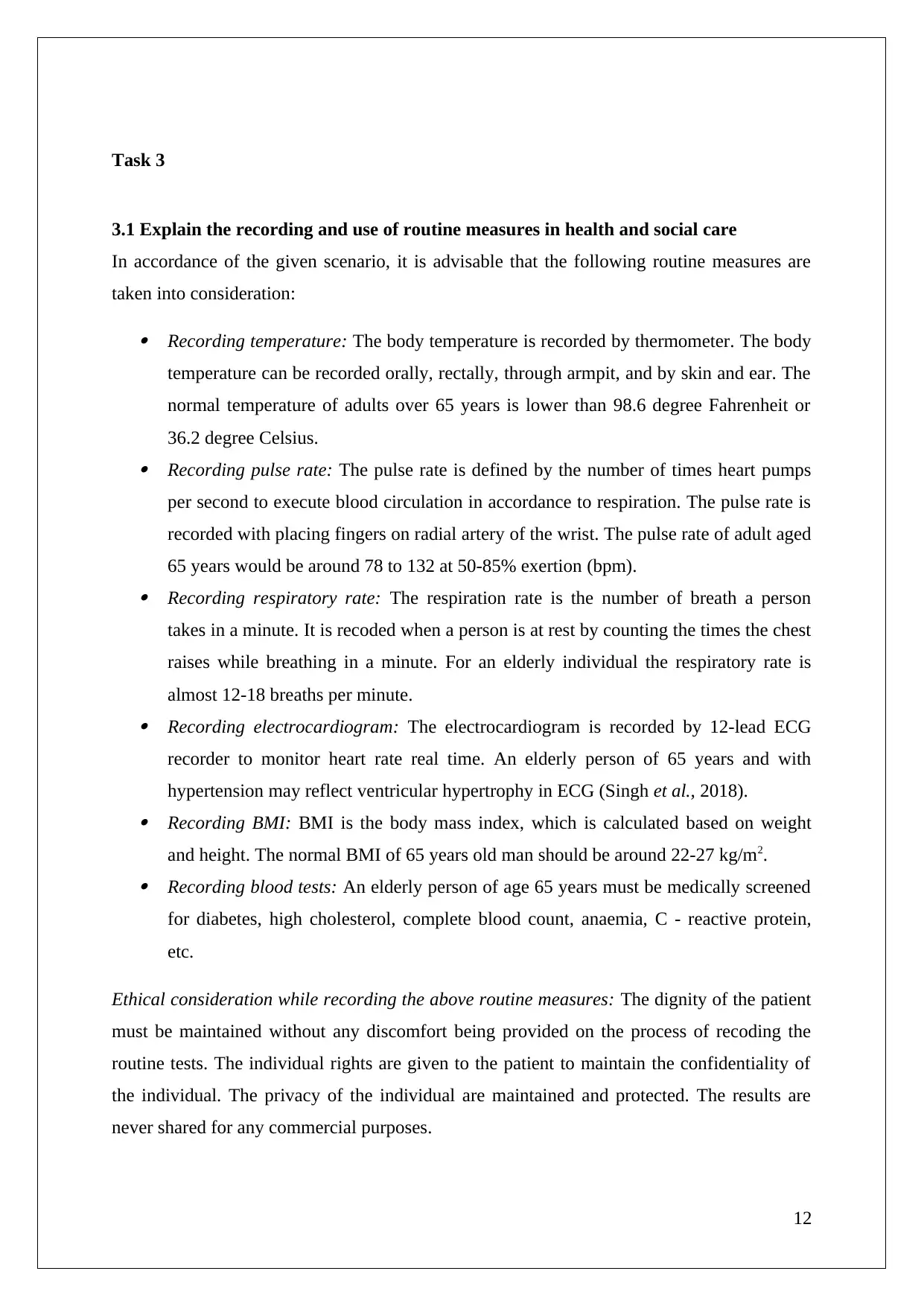
Task 3
3.1 Explain the recording and use of routine measures in health and social care
In accordance of the given scenario, it is advisable that the following routine measures are
taken into consideration:
Recording temperature: The body temperature is recorded by thermometer. The body
temperature can be recorded orally, rectally, through armpit, and by skin and ear. The
normal temperature of adults over 65 years is lower than 98.6 degree Fahrenheit or
36.2 degree Celsius. Recording pulse rate: The pulse rate is defined by the number of times heart pumps
per second to execute blood circulation in accordance to respiration. The pulse rate is
recorded with placing fingers on radial artery of the wrist. The pulse rate of adult aged
65 years would be around 78 to 132 at 50-85% exertion (bpm). Recording respiratory rate: The respiration rate is the number of breath a person
takes in a minute. It is recoded when a person is at rest by counting the times the chest
raises while breathing in a minute. For an elderly individual the respiratory rate is
almost 12-18 breaths per minute. Recording electrocardiogram: The electrocardiogram is recorded by 12-lead ECG
recorder to monitor heart rate real time. An elderly person of 65 years and with
hypertension may reflect ventricular hypertrophy in ECG (Singh et al., 2018). Recording BMI: BMI is the body mass index, which is calculated based on weight
and height. The normal BMI of 65 years old man should be around 22-27 kg/m2. Recording blood tests: An elderly person of age 65 years must be medically screened
for diabetes, high cholesterol, complete blood count, anaemia, C - reactive protein,
etc.
Ethical consideration while recording the above routine measures: The dignity of the patient
must be maintained without any discomfort being provided on the process of recoding the
routine tests. The individual rights are given to the patient to maintain the confidentiality of
the individual. The privacy of the individual are maintained and protected. The results are
never shared for any commercial purposes.
12
3.1 Explain the recording and use of routine measures in health and social care
In accordance of the given scenario, it is advisable that the following routine measures are
taken into consideration:
Recording temperature: The body temperature is recorded by thermometer. The body
temperature can be recorded orally, rectally, through armpit, and by skin and ear. The
normal temperature of adults over 65 years is lower than 98.6 degree Fahrenheit or
36.2 degree Celsius. Recording pulse rate: The pulse rate is defined by the number of times heart pumps
per second to execute blood circulation in accordance to respiration. The pulse rate is
recorded with placing fingers on radial artery of the wrist. The pulse rate of adult aged
65 years would be around 78 to 132 at 50-85% exertion (bpm). Recording respiratory rate: The respiration rate is the number of breath a person
takes in a minute. It is recoded when a person is at rest by counting the times the chest
raises while breathing in a minute. For an elderly individual the respiratory rate is
almost 12-18 breaths per minute. Recording electrocardiogram: The electrocardiogram is recorded by 12-lead ECG
recorder to monitor heart rate real time. An elderly person of 65 years and with
hypertension may reflect ventricular hypertrophy in ECG (Singh et al., 2018). Recording BMI: BMI is the body mass index, which is calculated based on weight
and height. The normal BMI of 65 years old man should be around 22-27 kg/m2. Recording blood tests: An elderly person of age 65 years must be medically screened
for diabetes, high cholesterol, complete blood count, anaemia, C - reactive protein,
etc.
Ethical consideration while recording the above routine measures: The dignity of the patient
must be maintained without any discomfort being provided on the process of recoding the
routine tests. The individual rights are given to the patient to maintain the confidentiality of
the individual. The privacy of the individual are maintained and protected. The results are
never shared for any commercial purposes.
12
⊘ This is a preview!⊘
Do you want full access?
Subscribe today to unlock all pages.

Trusted by 1+ million students worldwide
1 out of 23
Related Documents
Your All-in-One AI-Powered Toolkit for Academic Success.
+13062052269
info@desklib.com
Available 24*7 on WhatsApp / Email
![[object Object]](/_next/static/media/star-bottom.7253800d.svg)
Unlock your academic potential
Copyright © 2020–2025 A2Z Services. All Rights Reserved. Developed and managed by ZUCOL.





